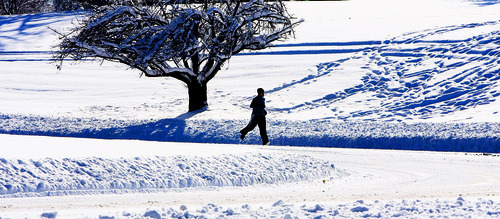This is an archived article that was published on sltrib.com in 2011, and information in the article may be outdated. It is provided only for personal research purposes and may not be reprinted.
Mountain snowpacks averaging 140 percent of normal across the state mean Utah's water supply is in great shape. But that bounty also holds a potential for spring flooding.
Whether rivers and creeks overrun their banks depends on how fast the ample mountain snow melts. But that's not predictable this early in March.
A cold, wet April and May followed by a warm June could spell trouble. But, according to Brian McInerney, a hydrologist with the National Weather Service, a mild April and May could yield spring runoff without flooding.
The big-snow winter of 2005-06 did not produce flooding. But last year, after a light snow season, the Weber River and Little Cottonwood Creek flooded after a cool, wet spring turned hot the first week of June.
The Virgin River Basin in southwest Utah has a snowpack that is 166 percent of normal, according to the weather service.
That was largely due to a giant December storm that dumped the equivalent of 20 inches of water in four days.
Snowpack also is up in the northern and central portions of the state, thanks to a La Niña weather pattern, McInerney said.
"When we look at the water year, we see very good numbers," McInerney said. "When we look at snow, the Bear River Basin is doing very well, and that's indicative of the whole state."
The exception is San Juan County, which is 90 to 99 percent of normal.
La Niña occurs when equatorial surface waters in the Pacific Ocean are colder than normal. That sets up a pattern that usually means colder and wetter weather for the Northwest and warmer and drier weather for the Southwest.
The position of a high pressure system in the mid-Pacific allowed November and December storms to roll through northern Utah.
But when that high moved on land from January through mid-February, it left Utah cold and dry with valley temperature inversions.
In contrast, when a large low pressure parked near the West Coast from mid-February through the beginning of March, it brought two large storms to Utah that added greatly to the snowpack, McInerney said.
Precipitation for February was 110 percent to 129 percent of normal statewide.
Reservoir regulators at the Central Utah Project are letting water out of the dams to make way for runoff, said Tom Bruton, Uintah operations and maintenance manager for CUP.
"We realize there is 150 percent snowpack up there," he said. "We have an elevated awareness of potentialities but we don't think there is more chance of flooding than in other high snow years."
CUP officials are re-evaluating the snowpack on a monthly basis, said Bruton. "We're hoping for an extended warm, but not hot, spring."
For recreation, the big snowpack could be a big plus, said Tim Gaylord of Holiday River Expeditions.
"This gives us all hope that we'll have plenty of water, even enough to get down smaller streams," he said.
But like Bruton and McInerney, Gaylord says the next two months can swing conditions either way.
The Salt Lake City office of the National Weather Service will not make its "peak stream flow" forecast for several more weeks. But two of three elements for spring flooding are in place, according to McInerney.
First, soil moisture is high due to a wet fall. Second, snow totals also are up. But the most critical aspect of predicting spring floods remains unknown — April and May weather.
Although it's not possible to predict those critical months at this point, McInerney said the forecast for the next seven days calls for a series of small storms to come through Utah. If that wet pattern continues, it could be problematic.
Uintah County officials already have warned residents of the possibility of flooding. The Duchesne River Basin that encompasses the southern slope of the Uinta Mountains has a snowpack of 135 percent of normal.
Mountain snowpack (percent of average)
Bear River Basin • 135
Weber River Basin • 145
Six Creeks drainage (Salt Lake County) • 145
Utah Lake drainage • 145
Duchesne River Basin• 135
Green River Basin • 119
Sevier River Basin • 132
Virgin River Basin • 166



